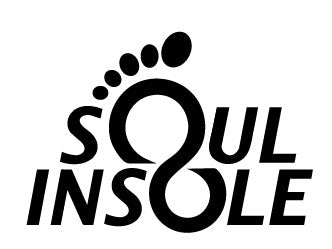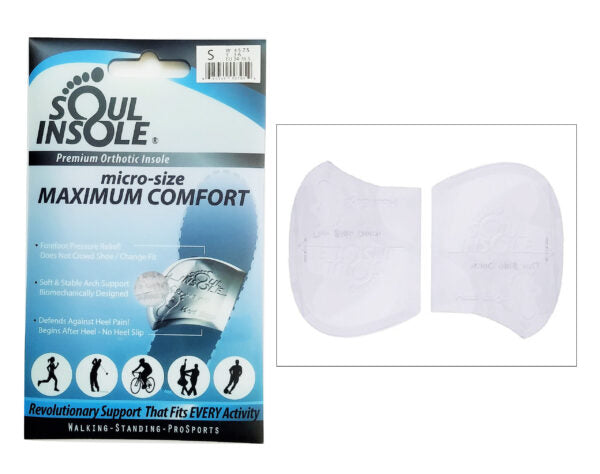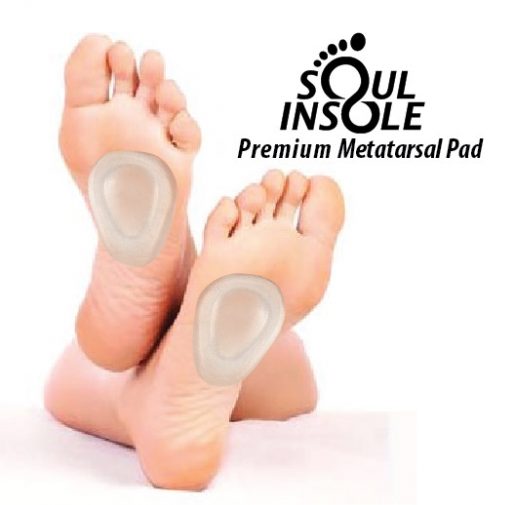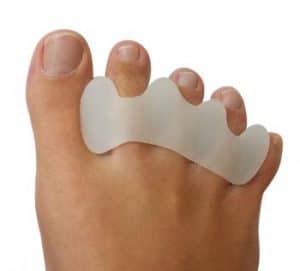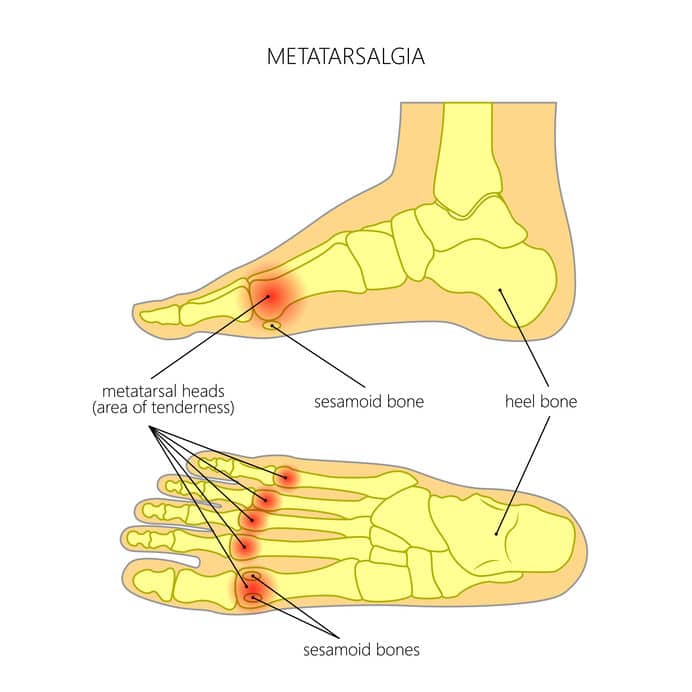
Forefoot ‘Ball of Foot’ Pain:
Conditions, Causes, Prevention and Solutions
Are you constantly feeling pain in your feet? Is the pain near your toes or ‘ball of the foot’ / forefoot? The pain is debilitating, but you do not know what the real reason behind the constant pain is?
Time to get to the bottom of this, as many times foot pain is directly linked with not knowing how to take care of the feet in the right way. Here is the ultimate guide for you to identify what the real cause behind certain types of foot pain may be. We hope this will help you to identify how you can get rid of your persistent foot aches.
Conditions
Some of the key conditions that are experienced as excruciating foot pain near the forefoot / ‘ball of the foot’ / toes are:
Metatarsalgia
Morton’s
neuromaSesmoiditis
Let us explore each of these 3 diseases one-by-one so that you can have a better understanding of each condition.
What is Metatarsalgia?
You can consider it as a symptom of another disease rather than a disease itself. Actually, it heralds that there is something wrong either with the way you walk or position your foot. Furthermore, you may have faced an injury due to some physical activity and you did not feel the pain earlier.
Symptoms of Metatarsalgia:
Sharp, aching, shooting or burning pain in the forefoot / ball of foot / area behind your toes
Pain that worsens when you stand, run, flex your feet or walk – more pain is experienced when
barefoot on a hard surface
Possible numbness, or tingling in your toesA
feeling of having a pebble stuck in your shoe
One of the biggest problems with this disease is that the pain does not always occur as soon as an injury happens. It may take a few months to feel the pain; however, once pain gets started it can continue for much longer.
Causes of Metatarsalgia:
Some of the key causes of Metatarsalgia may include but are not limited to the following:
Overuse injuries such as long hikes, long hours on the feet at work
High impact Sports such as jumping, running, soccer, tennis, baseball or football can put you at higher risk of experiencing an injury which can bring about metatarsalgia.
An after effect of that injury that caused little or no pain at the time of impact. That injury, if neglected, may get worse over time.
Weak muscles
Arthritis
Tight Achilles tendon
Ill-fitting footwear such as high heeled shoes or tight fitting ballet flats.
Prevention and Solutions
Luckily there are some things that can help in the prevention of metatarsalgia. If possible, do not wait long after an injury to the point where you are feeling extreme pain to take some precautionary steps to care for the feet. Here are a few ecommendations:
Apply ice to the area several times a day, each time for 15 to 20 minutes. Wrap the ice in a towel to protect the skin
You can use over the counter anti-inflamatories such as ibuprofen to reduce inflammation and relieve the pain
Try to keep pressure off the feet and keep the feet up when resting.
Use an over the counter insole that provides support to offload pressure
Use a Metatarsal Pad: This helps in taking pressure off the forefoot bones and providing spacing for the plantar digital nerve. It can aid in the reduction of burning sensations and ball of foot pain. We recommend this metatarsal pad as it has a reusable adhesive. You can apply it effortlessly and after using it, you can wash it to use again. This metatarsal pad can be combined with an over the counter insole to have increased relief.
What is Morton’s Neuroma?
Morton’s Neuroma, simply put, is where a nerve in your foot is injured or damaged. It more often causes pain in the ball of the foot; especially, between the third and fourth toes.
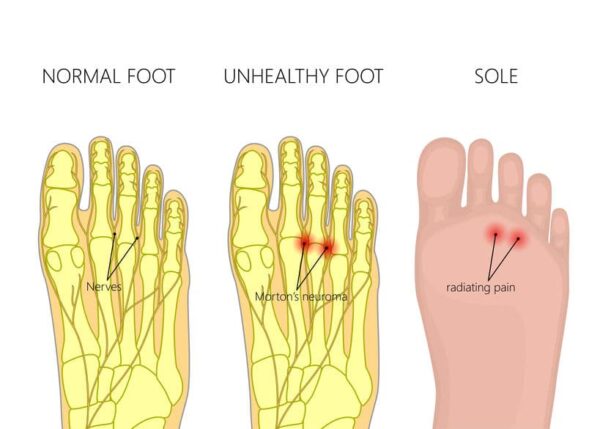
Symptoms of Morton’s Neuroma
The main symptoms of Morton’s Neuroma include:
A shooting, stabbing or burning pain in the front of the foot / forefoot / ball of foot / toes
A feeling similar to having a small stone stuck under your foot
Some may have tingling or numbness in their foot or toes
Increased pain and symptoms may worsen when you move your foot or when you wear tight or high-heeled shoes.
At the site of pain, it creates irritation and inflammation along with numbness for some people.
Causes Of Morton’s Neuroma:
Some of the key causes that increase the risk factors of this condition are given below.
Playing high impact sports or even some simple and regular activities such as jogging and running.
Wearing tight shoes like dress shoes, ballet flats and high heels. Other examples include wearing tight shoes while rock climbing or skiing. These shoes can put immense pressure on the toes and forefoot bones (metatarsals).
Having other foot problems: if you are already facing any problem such as hammertoes, bunions, flat feet, or high arches, then you are at elevated risk to develop Morton’s neuroma.
Treatment / Prevention Options For Morton’s Neuroma:
Stop wearing high heels and tight shoes. Wear shoes that are spacious and wide in the forefoot area.
Apply ice to the area several times a day, each time for 15 to 20 minutes. Wrap the ice in a towel to protect the skin
You can use over the counter anti-inflamatories such as ibuprofen to reduce inflammation and relieve the pain
Try to rest and keep pressure off of the feet. Keep the feet elevated when resting.
Use soft insoles and/or a metatarsal pad in your shoes.
Try to lose weight if you’re overweight
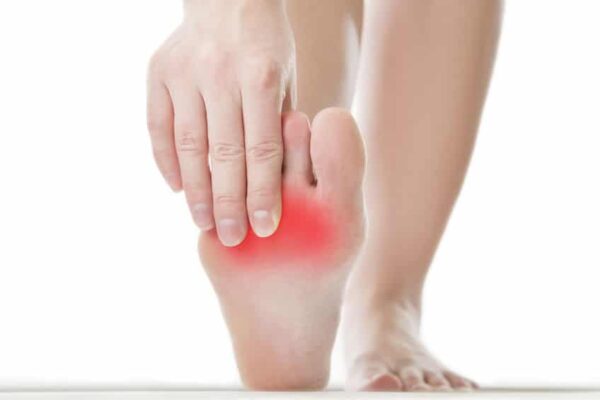
What is Sesmoiditis?
Sesmoiditis refers to any irritation of the sesamoid bones, which are tiny bones within the tendons that run to the big toe. The sesamoids function as a pulley, They increase the leverage of the tendons controlling the toe. Whenever you push off with the toe, the sesamoids are used, and eventually they can become irritated or even fractured. Most of the bones in the human body are connected at joints, but sesamoids are a bit different – the bones are actually within the tendons. So, sesamoiditis is similar to tendinitis – the tendons attached to the sesmoid bones also become inflamed.
The main symptoms of Sesmoiditis:
Gradual onset of pain under the ball of the foot
Bruising
Difficulty straightening or bending the big toe
Swelling
You may also have a popping sensation in your big toe when walking
Causes of Sesmoiditis
Damage to the sesamoid bones
High impact sports or activities requiring increased pressure on the ball of the foot (volleyball, running, gymnastics, basketball, football, golf, tennis and ballet.).
Walking in high heels or Boot marching.
People with higher arches, flattened arches, bony feet (lacking a fat pad under the feet).
Increased in body weight Increased training load / activity level.
Individuals who have a tendency to run on their forefoot.
The size of the sesamoids (the bigger, the higher the risk).
Deformation of the meta-tarso phalangeal joint or gout.
Treatment / Prevention Options For Sesmoiditis
Time to make some lifestyle and footwear changes.
Rest the Feet: Take some time off the feet to give them a chance to recover
Padding, strapping or taping. A metatarsal pad may be placed in the shoe, right behind the ball of the foot to offload pressure from the inflamed sesamoid area, or the toe may be taped or strapped to relieve that area of tension.
Immobilization. The foot may be placed in a cast or removable walking cast. Crutches may be used to prevent placing weight on the foot.
Oral medications. anti-inflammatory drugs, such as ibuprofen, are often helpful in reducing the pain and inflammation.
Physical therapy. The rehabilitation period following immobilization sometimes includes physical therapy, such as exercises (range of motion, strengthening and conditioning) and ultrasound therapy.
Orthotic devices. These orthotics help guide the foot into proper alignment and reduce pressure on the sesmoids. This can be a great long-term treatment of sesamoiditis to balance the pressure placed on the ball of the foot.
